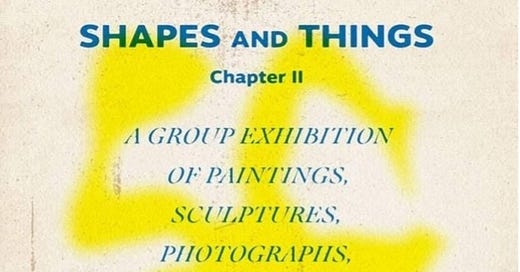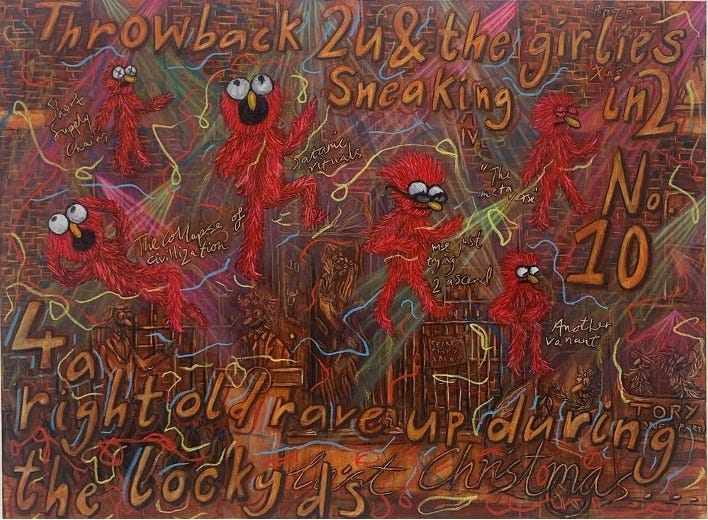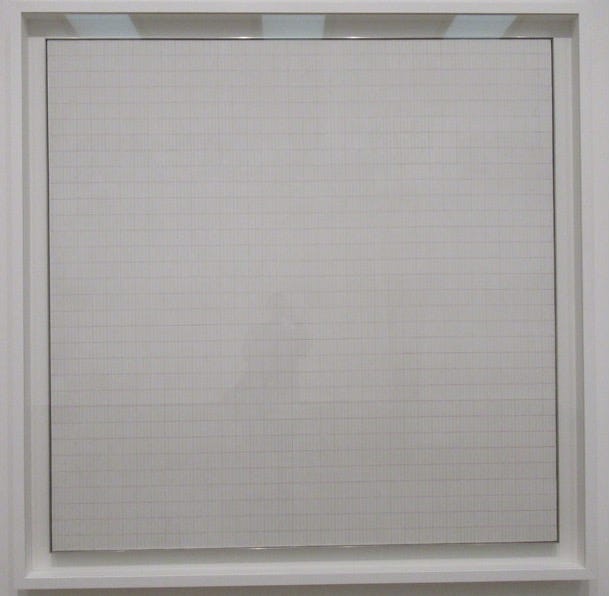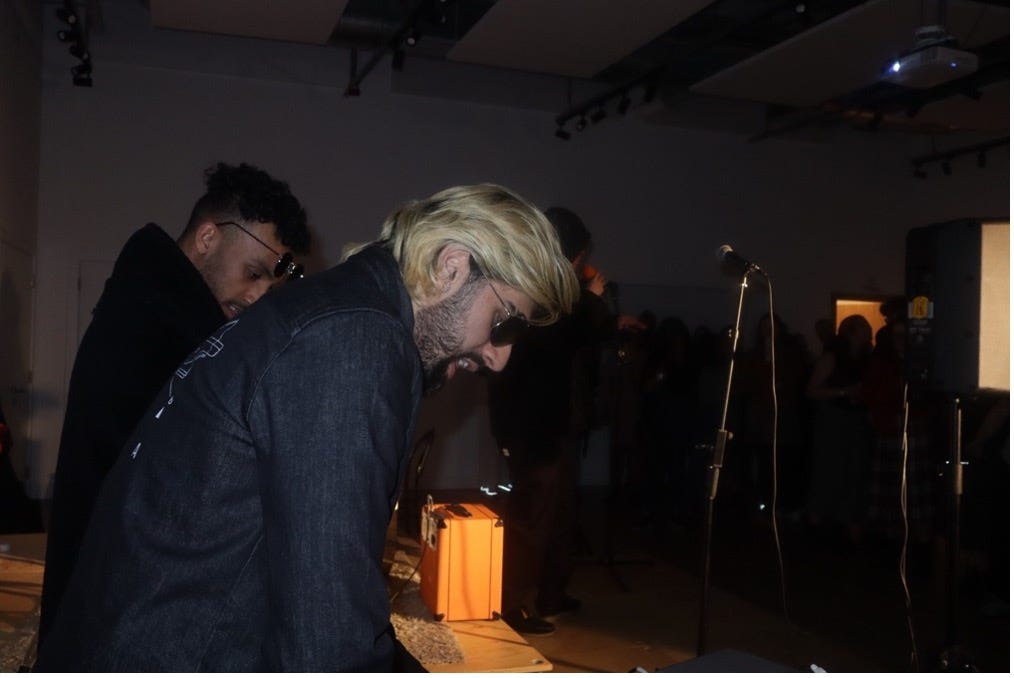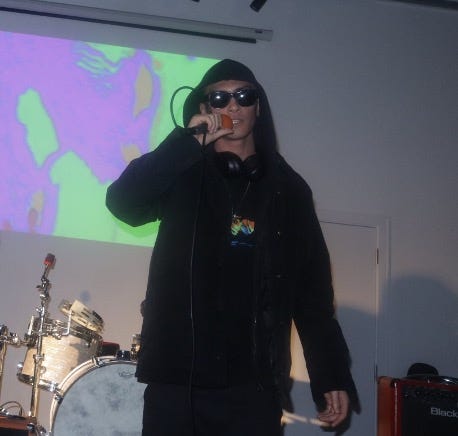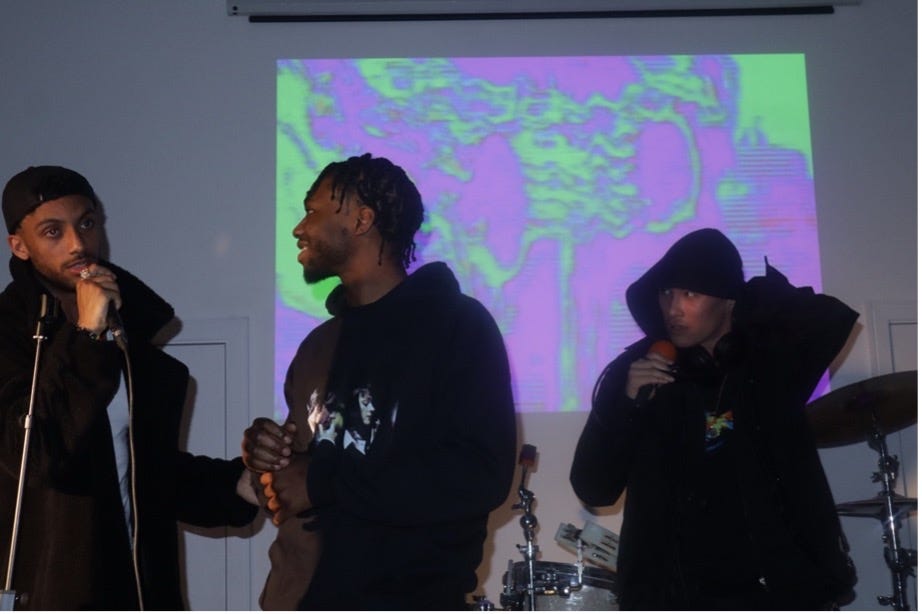Have you ever been to a place that is so challenging to your regular perception of things that you just want to look into a non-existent camera all confused like Jim in ‘The Office’ or Gregory in Abbott Elementary? Recently, I’ve been going to places that make me feel like this a lot. The challenging nature of new experiences, whereby you’re stunned into re-evaluating your perception of the world has become a new thrill for me. Its important because it is only through being challenged in our worldview that we can hold onto our most important beliefs- those that survive our intellectual challenges. But it’s also just fun to experience strange things. One of my most recent experiences with this was an event called Shapes & Things, which was held in Ealing on the 29th April. The event was set up like an immersive art experience running from 3pm-11pm, where you could get tattoos done, listen to live music and look at visual art. I didn’t get any tattoos done (nor would I ever) but in writing this, it makes me wonder what I would get if I did. It’s completely irrelevant to this piece but it’s on my mind. I found it exhilarating, because of how great and odd the entire set up was, so I’ve decided to write up some of the things I saw there.
Picture 1: The Jim stare
The entranceway to the Shapes & Things event reminded me of the Greek goddess, Hecate. She was the goddess of crossroads and standing in that entranceway, a white void of pathways where the sound of radio-glitch was bleeding out from the visual art room into the main space, felt very much like one of her snares. I considered whether going to the art or the music spaces first, but I decided music since I was there to see The Xutians, a hip hop Electronic duo, perform. I arrived just under an hour before The Xutians performance and they were halfway through a set by Jaso Maurice, a rapper who I had started listening to just a year prior. His rapping is usually part-diary entry confessionalism, part-youthful braggadocio over dreamy soul sample production. I was excited to see him replicate this live for me to sway and get lost in, but I walked in to see him holding a guitar, strumming rock chords alongside a bassist and drummer. The sound was harsh like they were purposefully incorporating dissonance in their piece and it was nothing like the soothing contemplative rap that Jaso usually makes.
Picture 2: The cover of Jaso's 'Heart Talk', the first project I heard from him
Jaso began to sing a rough lament story of a girl who had suffered at the hands of London. It felt like a metaphor for something: perhaps the misery at the heart of the human experience or the widespread dissatisfaction that is felt across post-pandemic Britain. It could have been either of those or neither, but his verse was haiku-like- short- and it transformed into an instrumental jam, allowing the drummer to break out into loud fills on his cymbals. The crowd loved it. Those in front of the stage were waving their hands emotively and there were people who had been talking during the set at the back and around the sides of the stage who had turned their attention to Jaso too. There was a unanimous consensus that they had touched something exciting. Then, a man sitting to the side of the stage started to play glitched-out soul sample chops from a sampler machine (a machine that can play sounds that are loaded up into it). It turned it from a rock jam into ambient, atmospheric experimentation. The sample chops gave more structure to the music and although I hadn’t expected it to be presented through a rock fusion, this was the sound that I had expected from Jaso. The samples immediately elevated the music, but Jaso’s time was up. He and his band strolled off the stage without offering a proper conclusion.
His set was carefree, completely at peace with its lack of structure. It was a scene of pedestrian experimentation, working out ideas on the stage with the calm acceptance of whichever reactions the music garnered. For the most part, he was studied with interest. His audience were unmoving, nodding their heads mostly and swaying on occasion. I’m fascinated by this style of performance. Many of my favourite artists from Miles Davis to Yussef Kamaal are known for emancipating themselves from structure too and I’ve seen improvised performances live, but this one felt different. It was a performance that intentionally felt like an experiment- warts and all- and the music had a unique feel of spontaneous, warped rock, but this challenged a lot of what I consider a performance to be- clean, punctuated, well-planned. At first it seems like this is a technical focus- details and structure. It is not. The more I think about it, the more Jaso’s performance challenges me because it was a statement of boldness. Jaso’s trust in himself and his bandmates that everything would be alright on the stage is an unnatural quality. It requires him to unlearn the innate fearful urge to control everything to ensure perfection and instead allows free, interactive conception, where performance becomes a greenhouse for new ideas to flourish musically and audience members become witnesses to blossoming, pollinating and helping the best flowers to grow.
I then went to look at some art for a bit. The collection on display was fascinating: it was full of the work of young artists, created to carve out niche analyses on very specific feelings and phenomena that characterise modern society.
The first piece that drew my attention was entitled Patience, which was a canvas filled with small masculine blue heads repeated in a grid. Their skulls were open, which revealed minute bronze sludges in the place of their brains. There were some small differences in the heads- one or two where the lips were slightly different to the others and some where bronze paint had been scribbled over them- which showed that the identical repetition was something effortfully intentional. At first, it felt to me like a display of collective enlightenment, since they all had peaceful smiles, but this imagery felt too Orwellian to me: a society of identical figures, at peace with their dull state of being identity-less and therefore, with no unique experiences of their own; bodyless, stripped of agency. The title therefore, felt like a prayer, like the quiet wait for a radical shift that could awaken these figures from their sedated placation. I didn’t take a picture of the piece but I wish I had, so that I could study it more and gain an understanding of the artist’s intentions.
This was the piece that I had spent the most time looking at. It was simple, but it spoke to me a message that I so desperately wished was positive. In our current climate, this is a necessary presentation of placation, because we are so at ease with the false solutions which we present ourselves with on a regular basis. Both us as individuals and the world-bodies that rule over us accept these false solutions too much. We post on our stories to complain about our crises and we take the knee/ wave Ukrainian flags/ post black fists/ wear rainbow pin bages/ hold silent memorials (or whatever other symbolic act that has been co-opted so much that it is now far removed from its original productive meaning). In truth, both us and these bodies should be rethinking the way we understand humanity in order to vanquish power imbalances and we should be replacing policies that aid in the maintenance of oppression with new policies that aid in the maintenance of fair and equally accessible quality of life for all humanity. The non-result is that we do the first set of many things that achieve nothing and we don’t do the second set of many things that would actually get us somewhere, so we just do things to avoid doing anything and resultantly, we end up existing in an endless loop of nothingness that looks like the symbiotic cycle of problems and protest. We don’t try to break out of this loop at all, so we are actually the blue men in the painting, smiling idly, comfortable with the collective sameness that we endure and at ease with our lack of agency.
I looked through a plethora of other pieces that largely dealt with escapism, brokenness and beauty. There was one piece in particular that was different from the rest and I felt positively challenged by it from the moment I laid eyes on it.
From afar, the canvas was a large flurry of brown and red, but the nearer I got, the clearer it was to see that the painting was accentuated by strikes of blue and yellow lightning as well as life-like floodlights passing through the piece. Most shockingly though, it depicted a mob of Elmo characters (yes, as in the Sesame street one) raving around, partying mindlessly in a dingy dungeon. Even without truly understanding the piece, I was captivated by it. It had words plastered across it too in bold cartoonish font that were spread across the page. For a few seconds, I was squinting my eyes and twisting my head to grasp their meaning and then I gasped in amusement. It read: ‘Throwback 2 U & the girlies sneaking in 2 No10 4 right old rave up during the locky d’s’. It was a mockery of the government’s lockdown parties! Suddenly, the Elmos were elevated from mere animated depictions to potent symbols for political incompetency, structural hedonism, and blatant corruption. I found myself in the corner of the room where the piece was, laughing at its ingenuity. I am sure that I looked odd to those around me for a few seconds because of my giggling excitement, but I couldn’t help it. Elmo’s clumsy, clown-like nature is a perfectly accurate representation of our current political leaders. But this excitement with the piece and its humour did not feel like enough to me.
Picture 3: Linda Carabali's ‘Throwback 2 U & the girlies sneaking in 2 No10 4 a right old rave up during the locky d’s’
It just felt like a nice piece that was funny but didn’t leave enough to the imagination, whereas my favourite forms of art are those that use subtlety to convey profound meaning. For example, one of my favourite pieces ever, Morning by Agnes Martin, is a totally minimalist work: a white canvas with grid lines drawn into it with pencil[1]. It conveys the simpleness of morning joy, waking up completely at peace within a moment of untroubling stillness. It is a quiet peace in that it doesn’t say too much and yet, even in that quietness, it is able to convey such impactful feeling that imprints its audience. Contrastingly, there are many artists who have no real subtlety or in fact anything to convey. We are flooded with them on our social media feeds nowadays: artists who are trying to gain visibility by making art that fits a certain cultural aesthetic or art that uses bold and recyclable slogans to double as virtue-signalling Instagram posts. It’s this lack of effort to convey anything new or anything profound and this tendency to scream the art’s purpose to the audience that cheapens this type of art for me. The bold writing and the comedic style of this artist’s piece felt at first like it followed this same path (albeit, in a way that looked much better than I have ever seen) but I continued staring at it for a while and realised that it was not like these at all.
Picture 4: Agnes Martin's 'Morning'
I noticed that it had more messages etched within it. In small italic writing, you could see messages like ‘The collapse of civilisation’, ‘The Metaverse’ and ‘short supply chains’ embedded within the scene of madness. They were all epithets of the pandemic period and its aftermath, blending the political and the personal crises that characterised it. There was one element of this tale that caused me to raise my brow at first: a message which read ‘satanic rituals’. It was the most provocative and possibly the most interesting phrase to use because it encapsulates the hyper-paranoia through which society lived within during this period. The American storming of the capital, the alarming spread of misinformation and the rampancy of conspiracy theories are all perfect examples of this and all of them were caused in part by the fear of such issues ruining the fabric of our society. The ubiquity of these examples, crossing both boarders and the threshold between the digital and physical worlds is in spite of the piece being a niche satire of a specific event in British politics. This showed to me the skill in this artist’s work to imbue not just meaning, but meaning that is universal and thought-provoking.
Picture 5: close up of ‘Throwback 2 U & the girlies sneaking in 2 No10 4 a right old rave up during the locky d’s’
It was amazing that these small messages were hidden within this depiction of the government’s lockdown parties because it successfully showed how, within these crises- our collective despair- the government were dancing gleefully, oblivious to the writing on the wall.[2] One could only ask how different this piece was from reality, where we also consume the news of constant government scandals and blunders like an amusing grand tableau, despite the fact that behind this, there are numerous political and personal crises that are being etched into the walls of our current climate (e.g. the cost-of-living crisis, underfunded and inadequate GP services, serious educational gaps in schools).
It showed me that we are living in this piece, which felt like something that the artist was intentionally trying to explain. Although there were no characters in the painting’s scene that were equivalent to the public or ‘us’. The writing on the wall symbolised our concerns and the troubles that these times presented us with adequately. This was what separated this piece from any of the lacklustre pieces I was referring to prior: the artist, Linda Carabali, is able to conceal poignant and touching messaging within vibrant and lively depictions. It’s a skill to capture quiet truths within the noisiness of saturated artwork and this in itself is reflective of the times we are living in. By painting out our problems in this visible way, it allowed us to latch onto things in the piece that were both familiar and painful, bringing to light the reality within its comedic absurdity. Furthermore, the juxtaposition between the deeply catastrophic labels on the wall and the exaggeratedly humorous Elmo figures dancing around the painting captured that initial feeling of hurt and humour of the public mood at hearing of these lockdown parties. Many of us laughed at their behaviour when we first heard the news, taking it as proof that they were clowns, but what does it say about us that we are ruled over by them? It’s an amazing skill to subtly capture these feelings.
It must be said as well that even its bold writing, which I did struggle with primarily felt perfect for our ages. It is Instagrammable and it does fit the conventions of meme-content but not to its detriment. Instead, it uses its bold messaging to draw in the audience and to allow us to be amused before forcing us to confront the very things that we fear and despair over. It only creates the feeling of giving secrets away, when in fact it is a layered tale with multiple elements throughout that the audience must engage with to uncover their truths. It manages to do so in a way that is bursting with personality and it made me excited to uncover more of Carabali’s work, so I ordered her new book, ‘Fuckery’, which acts as a literary manifestation of these themes[3] when I got home.
The segment I was most excited for was Marvin Jupiter’s. He is the other half of The Xutians duo and he is the face of the group, whereas Niv was the DJ for their performance. I was only expecting greatness from them. The Xutians are part of a larger group called ‘New Generation Creation’, which is a creative hub of friends that treat each other like family. Marvin insisted that his NGC friends present themselves to the audience with him: Ezy (which is Niv’s stage name), Bliss and Bizy. They stood together like a coy boyband for a moment before disbanding to play their understood roles.
Picture 6: Niv Babraa DJing next to NGC Bizy
Marvin announced that he was only performing songs from his new album, The Love Album, nearly all of which is unreleased. This seemed like an odd choice to make since he immediately alienated some of those in the audience who might have recognised his songs. He even acknowledged how unwise this looked. Only those who had heard snippets of the album were familiar with the tunes, but even then, a lot of his set was new to our ears. This was good in a way. It allowed us all to listen with open ears and appreciate his performance as it unfolded.
Rather than presenting songs that we would be familiar with, Marvin described his music to the audience using sentiments that were relatable to some of those in front of him: most of them his vices: Depression, drinking and smoking. It was all set to the backdrop of ambient funk and 808’s. My favourite song was one shaped by escapism. He narrated a tale of finding a utopia and therefore peace. This portrayal of peace as a place which we must find was universally accessible, since it captured both our need to flee the things that hurt us and find the things that bring us joy. Over the past two years, where constant restrictions on our ability to leave our homes have made escapism a treasure that we long for but struggle to find, this song felt like a precious moment.
Picture 7: Marvin Jupiter performing
Most of his lyrics used the imagery of intimacy to paint his thoughts, particularly those that had a morose slant. ‘I want you to myself’, he repeated over and over again in one song. This perplexed me as well. Who has broken Marvin Jupiter’s heart so badly that he associates all his pain with women? I jest.
It was still an interesting choice because many of his songs used this specific imagery, whereas for the rest, he would eschew this entire metaphor and rap vigorously, shooting off quick rhymes that would paint his day-to-day life with his friends and family quaintly. Just like any public relationship, this musically fabricated romance is a magnet to critique and analysis. It’s as if he is using it to show that he has an unhealthy relationship with his vices, he cries over them and serenades them with eager attention, cherishing their presence in his life, without offering much regard to the inner degradation that they cause. It’s a classic presentation of love and vice, famously used by Mac Miller throughout his career on albums like Faces, Circles and Swimming. But Mac Miller’s music was trying to blur the lines between love and addiction; Marvin’s music is different. The only addiction Marvin presents is the addiction to his own sadness but even this is not constant. It is more of an obsessive fling, from which he unentangles himself at times by seeking happiness, joy and community. The way in which he navigates through this plethora of emotions with a contrast of opaquely minimal symbolism (which depends on this intimacy imagery) and lucid self-analysis showed that he was using this metaphor then to present pain as something that you get lost in, something numbing and intoxicating. He even confirmed this at one point in rapping, ‘You don’t know what the blue pill is? You’re using it’, in reference to the film, ‘The Matrix’, which is an allegory for self-awareness. It’s a nuanced presentation that allowed him to comfortably navigate through joy, escapism and depression all through one coherent set and those in the audience moved with the same comfortability too: feeling most at ease when he described a song as an encapsulation of something sad- the irony of finding comfort in relating to other’s woes.
However, this inaccurately presents Marvin’s performance as a sad one. It was upbeat, vibey and engaging. One of the highlights of the set was the performance of the ‘Love Anthem’. Before performing this song, Jupiter informed the audience that this was one of his most streamed songs. They applauded him for the achievement and strangely, it was as if this upset him. He had a smile which had become a frown and he cut through the round of applause shouting ‘Fuck The Industry. Never release your music. Just make music for yourself.’ Everyone laughed at this exclamation, and they danced along to the fun Neptunes-esque song. I danced too, singing along to the chorus happily, but my mind was still on Marvin’s outburst.
Picture 8: Marvin Jupiter on stage with Bizy and NGC-affiliate, Meech
I know that like many in the creative community around him, Marvin exists as a maverick- no labels, no contracts, no management, just creatively focussed autonomy. Yet, it felt slightly paradoxical that him and Niv were standing there performing in clothes given to them by Caterpillar, the famous clothing brand, whilst giving ‘the industry’ the finger. Furthermore, what did he mean by the industry? By mentioning streams, it’s clear that he was talking about the streaming companies, the advertising brands and the corporate enterprises that had played a role, even if an insignificant one, in getting Marvin’s music out there. But even this didn’t make sense: I know Marvin personally and some of his biggest inspirations- e.g. Keith Haring and Pharrell Williams- had some of the most prolific outputs of their times. They were paraded by this same industry. It was possible that he had just said this for cheap shock value, but everything about him, from his beats, to his persona and his lyrics were all calculated, perfectly placed and focussed, and so was this outburst. It was too loaded with conviction to be a simple stunt.
Marvin’s inspirations, although pioneers of the industry, are also mavericks like him. They might have been entrenched in the industries of their world, affiliating with the figureheads of industry and working closely with the corporations, but their art is still understood to be transgressive because of the way they attacked the mould of who they were supposed to be. Each of them redefined masculinity within their art forms, but they individually imprinted shifts in popular thinking too- Keith Haring turned street art into high, popular art and used the medium, which the industry associated with poverty and violence, to present life as a colourful, vibrant and inter-connected; and Pharrell changed rap, transporting the gritty machismo of its 90s era into the safer spaces of the mainstream, where rappers’ expression was celebrated more positively.
Marvin’s outburst therefore should be contextualised within this same intent. He too is on a pursuit of turning the unacknowledged and the unappreciated into something valuable. And whilst Marvin’s music is definitely a touch avant-garde and his song writing is unique, it is safe to say that the emotion that he brings to his music is his most radical quality. This is what he is elevating. His shifting styles, as I have explained, changed from romantic crooning to unfaltering bars and with these changes, so did his emotional vocabulary. Sometimes, he was unwisely falling into his sorrows and sometimes he was wiser, celebrating the love and the community that he has around him like on the love anthem. Notwithstanding, these emotions are not binary or easily distinct. They are nuanced. His saddest songs paint the joy that he feels from the things that cause him harm and his happiest song, ‘The Love Anthem’, is a celebration of the pursuit of joy in spite of pain, hardship and suffering. Even Jaso, who had performed just before (and who is a childhood friend of Marvin’s) rapped on one song dedicated to him, ‘My brother Marv took a hit/ Didn’t let it whack him’.
This observation is sufficient explanation for most of Marvin’s music. He is lifting himself up, just as his inspirations brought up the world of their art styles and he is doing so in spite of his circumstances. This shows the value of his innate quality to find nuance in himself in a world of absolutism, where messaging in music resigns to singular emotions and communications in society are character-limited, leaving no space for the nuance that Marvin Jupiter finds. This spirit of absolutism has led itself no doubt to the many streams of ‘Love Anthem’. Its chorus cries out: ‘We’re calling all the lovers’ again and again, which is catchy. However, this catchiness leads it into the trap of losing its nuance. It becomes a song of unbridled positivity, without its verses- reflections of Marvin relying on family and community to keep him afloat despite struggles- possessing value anymore. It’s this butchering of his song, where his intended meanings are treated like unwanted giblets that he has to sit by and watch get thrown away, that causes him to say fuck the industry.
This outburst makes even more sense when you consider that he exclaimed ‘Never release your music. Just keep it to yourself’ just after. This music is his self-expression and whilst this is important to him, releasing it means abandoning it to the machine of industry. It paints an image like the film, ‘Prince of Egypt’, where musicians are Miriam- parents to their creations that can only hold onto their children for a short period before they are given away to the rivers of consumerism. Through these rivers, they flow towards commodification and grow into things that they were never intended to. Nevertheless, it is a feat that Marvin, like his inspirations, is still able to hold onto his art so deeply before it is released, and I know that this ability to showcase his emotions through his art purely as he intends is worth it to him even if just for brief moments.
I left shortly after Marvin Jupiter’s set, feeling appreciative to have attended the event. It was refreshing to see politics (or more aptly general commentary about our relationships with those that have power over us) existing accessibly within the realms of art. This is of course common throughout the art world, but its existence at the Shapes & Things launch was non-intrusive, engaging and exciting, inviting us to question the way we interact with the powers that be and make active steps ourselves to thinking autonomously. Even Jaso Maurice, whose set was void of any politics, painted this message himself in creating music that was spontaneous, free and bold because he too was devoting himself to this spirit of free thought and defiance, one which we must all embody.
[1] Almost every time I’ve seen this piece in person, there has been someone next to me who has laughed that it looks like the paper we used to see in our maths textbooks at school haha
[2] Ahh, the writing on the wall! What a perfect analogy for the times we are living in *chefs kiss*
[3] She calls the style meme-inception.
